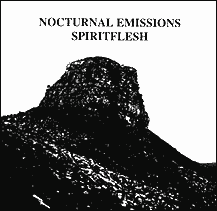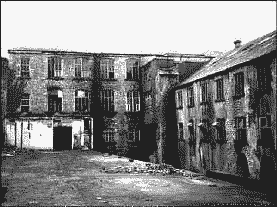One way to break through this myth is to look at the conflicts that continue to rage in the Middle of England. With this in mind, we look to that most rational of imaginary systems, mathematics, to find the middle of England. We simply divide a map of the country into North-South and East-West lines and where they cross is the centre. If you try this for yourself you will most likely find that the lines cross on or about the area usually known as the Midlands.
| The exact centre by my own calculation lies close to Tideswell, in the Peak District, at a rocky outcrop known as Peter's Stone. This lies at the base of the Pennines, the backbone of England, so using a human body- land-mass metaphor, this locates it at what martial artists call the hara, or exact point of balance of the body. Peter's Stone bears a curious resemblance to the Omphalos at Delphi, said to be the exact centre of ancient Greece, where stood a special stone used as an oracle. Here is a photo of Peter's Stone from the cover of the Nocturnal Emissions Spiritflesh LP. |  |
As a variation to the above cartographic exercise, you can add the psychogeographic boundaries of Scotland, Wales and Cornwall or as many of the other British Isles as fit your model of Nation, and see where the middle lies then.
The more mystically inclined may be interested to know that, according to Medieval historians, a version of the above map-dividing exercise was suggested to the mythic King Ludd, when he was having certain trouble in his kingdom. These troubles were caused by a pair of dragons fighting at the centre of his kingdom. King Ludd was of Trojan descent, and a keen town planner. He is said to have built a New Troy, which was later called Luddein or London, in his honour. It's open to speculation if this early London was shaped like the old Troy, with maze-like ramparts, which the Welsh call Caerdroya. This Troy Town, a seven-looped maze, can be found in many ancient ceremonial sites throughout Europe.
The name of Ludd is commemorated at London's Ludgate Circus. In the Midlands, Lud's Church is an awesome rocky chasm in the Back Forest above the Dane valley in Staffordshire. This is the place where Sir Gawain is said to have faced the Green Knight. There is also a famous white stone, Luddenden Dean, West Yorkshire said to be 'freshly painted by persons unknown every May Day morning as part of a continuing - and secret Celtic tradition.'
The name Ludd resurfaced in the English Midlands, during the time of social upheaval when the middle and working classes, were created. The term Luddite has come to be applied to any opponent of industrial change or innovation. According to Collins Dictionary it is any of the textile workers opposed to mechanisation who organised machine-breaking between 1811 and 1816. The Luddites are allegedly named after Ned Ludd, an 18th century Leicestershire workman, who destroyed industrial machinery. Rybcznski, in 1983, mentioned they may also have been named after King Ludd.
The Luddites have been depicted as a group that organised resistance to technological change. They are said to have organised against technological advances in the textile industry. However this was not rejection of technology per se, but rejection of technology which was being used in a certain way to threaten their life and livelihood. The textile industry had consisted of many home-based artisans, working to their own hours, now what was being introduced was the destruction of this piece of workers' autonomy and the introduction of slave labour in the new textile mills.
When Richard Arkwright built his Dark Satanic Mills, they were complete with gun ports to deal with potential opposition. He built a prototype water spinning mill at Cressbrook, Derbyshire in 1779 (the site was chosen only a couple of miles from the exact centre of England, and according to the geomancer Nigel Pennick, the water-mill symbolises the old northern religion's link between heaven, earth and the underworld). When the water-mill patent was nullified, a number of local land owners jumped on the bandwagon and built similar factories. Accounts published in the Ashton Chronicle in 1849 tell of how boys and girls of seven or eight years old were taken from London workhouses and apprenticed in Cressbrook and Litton Mill. Children attempting to leave these apprenticeships were sentenced to imprisonment in the House of Correction. The working hours of these child slaves were from before five in the morning until nine or ten at night, with no time allowed away for meals. Thomas Blincoe wrote in his memoirs:
'...Ellice Needham, the master, had five sons, Frank, Charles, Samuel, Robert and John. These young men, particularly Frank and Charles, used us very cruelly, together with a man named Swann, an overlooker. they used to go up and down the mill with hazzle (sic) sticks, out of the wood, and lay on us most unmercifully. Frank once beat me till he was frightened himself. He thought he had killed me. He had struck me on the temples and knocked me dateless. I was a long time before I came to myself again. Swann had a stick about two feet long with a pin or needle filed at the end of it, and would come slyly behind us, and run it into the thigh or any other part of the body, when we were not thinking about it. He once knocked me down and belaboured me with a thick stick over the head and face, cursing me in the most horrid way. To save my head I raised my arm, which he then bent with all his might. My elbow was broken. I bear the marks, and suffer pain from it to this day, and always shall as long as I live. The bone was fractured, but never had any notice taken of it. It was very seldom that we missed a day without being beaten in the most cruel and wanton manner...'.
Although the news doesn't seem to have filtered onto the Internet yet, it was against these horrific working conditions, rather than the greater efficiency afforded by new technology, that the Luddites fought.
| I visited Litton Mill today, it stands in a beautiful wooded valley, close by a nature study centre and a Youth Hostel. The mill buildings are derelict, with smashed glass in the window-frames; it's an eyesore, the sort of place an Industrial music band would photograph for its record sleeves. There has been building work taking place on the site, which claims to be completed in 1996, it is now 1997 and the work looks abandoned. Notice boards nearby document the plans to turn the Mill into time-share flats and the application for funding put into the National Lottery, highlighting the opposition of local residents to the scheme. |  |
Back in the dictionary; the words that follow Luddite, ludicrous and ludo appear to have their roots in the Latin word meaning to play. To reframe the Luddites in the context of the late 20th century avant-garde, we can see that Ludd was in fact a multiple-user name.
A multiple-user name is a name that can be used by anyone and is connected to radical theories of play. Some proponents of the concept also claim that is a way to 'practically examine, and break down western philosophic notions of identity, individuality, value and truth'. The invention of these 'collective identities' has quite wrongly been attributed to the British mail artists Stefan Kukowski and Adam Czarnowski in the mid-seventies, with their multiple-user-name Klaos Oldanburg, followed by the American mail artist David Zack`s Monty Cantsin. This is simply an example of artists slowly catching up with, and mimicking tactics already being used elsewhere in the cultural arena. Multiple-user names have been popular for centuries in 'non-art' fields; the Robin Hood of the Dark Ages, the Kilroy of 'Kilroy was Here' graffiti fame, the multiple-author thrillers by Nick Carter, the early-seventies Wally cult, and the millions who have signed guest books as Mickey Mouse, are just a few who spring to mind. Other current examples are Karen Eliot and Luther Blissett.
The Ludd name was used by activists in variations such as General Ludd and Ned Ludd. A Lady Ludd led a food riot in Leeds. Luddite men cross -dressed as Ned Ludd's Wives. The Luddites were very aware of the power of myth and metaphor, one Luddite writer describes Sheffield as a City of Vulcan.
A modern-day opponent to the Luddite movement as a precursor to trades unions called it 'collective bargaining by riot'. The Luddites were crushed when the English Parliament dispatched 12,000 soldiers and the leaders of the movement were either executed or deported to Australia. A similar, but separate uprising in 1830 led to the destruction of threshing machines by farm workers in the countryside down south. This lesser-known, but apparently more effective movement used the multiple-user name of Captain Swing.
Over in the USA at the moment, hogging a fair amount of Internet space, there is a group calling itself the Neo-Luddites, with its chief spokesman the writer Kirkpatrick Sale. Sale dresses in Regency garb to pose as a channel to Ned Ludd, wrecking computers as a piece of performance art to enliven his lectures. This Neo-Luddite movement, rather than addressing the social use of technology like the Luddites of old, seems to be an effort to create the timewarped environment of an imaginary 18th century lifestyle.
It is nearer to Disneyland than Middle England.
Nigel Ayers, Derbyshire, England, 23 January, 1997
a Network News Online Exclusive